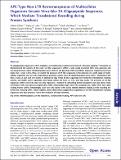Files in this item
APE-type non-LTR retrotransposons of multicellular organisms encode virus-like 2A oligopeptide sequences, which mediate translational recoding during protein synthesis
Item metadata
| dc.contributor.author | Odon, Valerie Marie Nathalie | |
| dc.contributor.author | Luke, Garry Alec | |
| dc.contributor.author | Roulston, Claire | |
| dc.contributor.author | De Felipe, Pablo | |
| dc.contributor.author | Ruan, Lin | |
| dc.contributor.author | Escuin, Helena | |
| dc.contributor.author | Brown, Jeremy | |
| dc.contributor.author | Ryan, Martin Denis | |
| dc.contributor.author | Sukhodub, Andriy | |
| dc.date.accessioned | 2013-08-08T11:31:02Z | |
| dc.date.available | 2013-08-08T11:31:02Z | |
| dc.date.issued | 2013-08 | |
| dc.identifier | 63279085 | |
| dc.identifier | 78687072-298f-4dd0-b3a8-c3d5e450fba3 | |
| dc.identifier | 000321820400019 | |
| dc.identifier | 84884241035 | |
| dc.identifier.citation | Odon , V M N , Luke , G A , Roulston , C , De Felipe , P , Ruan , L , Escuin , H , Brown , J , Ryan , M D & Sukhodub , A 2013 , ' APE-type non-LTR retrotransposons of multicellular organisms encode virus-like 2A oligopeptide sequences, which mediate translational recoding during protein synthesis ' , Molecular Biology and Evolution , vol. 30 , no. 8 , pp. 1955-1965 . https://doi.org/10.1093/molbev/mst102 | en |
| dc.identifier.issn | 0737-4038 | |
| dc.identifier.other | ORCID: /0000-0002-0012-0614/work/47136063 | |
| dc.identifier.uri | https://hdl.handle.net/10023/3945 | |
| dc.description.abstract | 2A oligopeptide sequences (“2As”) mediate a cotranslational recoding event termed “ribosome skipping.” Previously we demonstrated the activity of 2As (and “2A-like sequences”) within a wide range of animal RNA virus genomes and non-long terminal repeat retrotransposons (non-LTRs) in the genomes of the unicellular organisms Trypanosoma brucei (Ingi) and T. cruzi (L1Tc). Here, we report the presence of 2A-like sequences in the genomes of a wide range of multicellular organisms and, as in the trypanosome genomes, within non-LTR retrotransposons (non-LTRs)—clustering in the Rex1, Crack, L2, L2A, and CR1 clades, in addition to Ingi. These 2A-like sequences were tested for translational recoding activity, and highly active sequences were found within the Rex1, L2, CR1, and Ingi clades. The presence of 2A-like sequences within non-LTRs may not only represent a method of controlling protein biogenesis but also shows some correlation with such apurinic/apyrimidinic DNA endonuclease-type non-LTRs encoding one, rather than two, open reading frames (ORFs). Interestingly, such non-LTRs cluster with closely related elements lacking 2A-like recoding elements but retaining ORF1. Taken together, these observations suggest that acquisition of 2A-like translational recoding sequences may have played a role in the evolution of these elements. | |
| dc.format.extent | 11 | |
| dc.format.extent | 430351 | |
| dc.language.iso | eng | |
| dc.relation.ispartof | Molecular Biology and Evolution | en |
| dc.subject | Retrotransposon | en |
| dc.subject | 2A-like sequences | en |
| dc.subject | Translational recoding | en |
| dc.subject | APE-type non-LTR | en |
| dc.subject | QH426 Genetics | en |
| dc.subject.lcc | QH426 | en |
| dc.title | APE-type non-LTR retrotransposons of multicellular organisms encode virus-like 2A oligopeptide sequences, which mediate translational recoding during protein synthesis | en |
| dc.type | Journal article | en |
| dc.contributor.sponsor | BBSRC | en |
| dc.contributor.institution | University of St Andrews. School of Biology | en |
| dc.contributor.institution | University of St Andrews. Biomedical Sciences Research Complex | en |
| dc.identifier.doi | https://doi.org/10.1093/molbev/mst102 | |
| dc.description.status | Peer reviewed | en |
| dc.identifier.grantnumber | BB/H007849/1 | en |
This item appears in the following Collection(s)
Items in the St Andrews Research Repository are protected by copyright, with all rights reserved, unless otherwise indicated.

